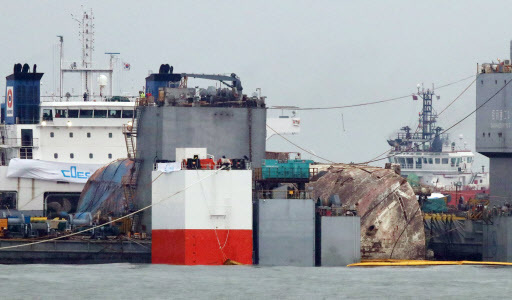The Sewol ferry was safely placed onto a semisubmersible vessel on Saturday morning, completing the trickiest part of the salvage and increasing the chance of a completion by early April, as scheduled.
"We completed loading the ferry onto the semisubmersible ship at 4:10 a.m.," Lee Cheol-jo, an official in charge of the operation from the Ministry of Oceans and Fisheries, said during a briefing.
Loading the ferry onto the semisubmersible vessel was one of the most challenging stages of the salvage operation. The government had hoped to complete it before the neap tide ended Friday as the process is hugely affected by the weather conditions.
“It is expected to take three to five days to finish preparing the Sewol to move to Mokpo Port after draining sea water and oil from the ferry,” Lee said.

The ministry originally forecast that the Sewol would be brought to shore by April 4, weather permitting. But with the most complicated steps of the operation out of the way, it could happen a few days earlier if the next steps proceed smoothly.
It will take three to five days for salvage operators to untie the 145-meter-long ferry from the two barges, drain water and oil from the ferry and fix it to the semisubmersible ship before finally transporting it to the port of Mokpo, some 87 kilometers away.
As of 10 a.m., the ministry said that the salvage team is untying the wires from ferry, which will continue until noon, and the semisubmersible ship is 2 meters above the water.
The vessel carrying the Sewol will begin to refloat after the boats that transferred the ferry are detached. After it rises 9 meters, the remaining hull of the Sewol will rise into full view. When it rises 16 meters, it will be ready to transfer the Sewol to Mokpo Port, the ministry said.
It takes a day for the vessel to reach the port and another few days to move it onto a dry dock at the port.
A total of five tug boats began to carry the ferry connected to two barges at 4:55 p.m. and arrived at the semisubmersible ship some 3 kilometers away at 8:30 p.m. on Friday. The Sewol was lifted to its target level, 13 meters above the sea, at 11:10 a.m.
Friday night was the last day of the neap tide period, the de-facto deadline for the delicate initial operations affected hugely by tides and weather conditions -- the raising the sunken ferry to the surface and fitting it onto the semisubmersible vessel.
The salvage effort faced an unexpected hurdle on Thursday night after the team found a ramp on the left side of the ship to have come unlocked underwater. The ramp was successfully cut off and the operation resumed at around 6:45 a.m. Friday.
The ferry, which was lying more than 40 meters below the waves, emerged from the water between two jacking barges on early Thursday morning, nearly three years after it sank off the southwestern coast.
Some 450 salvage workers began the operation to raise the sunken ferry Wednesday night. The two barges were positioned on each side of the ship and beams were installed under the wreck to allow the lifting.
The nation's biggest maritime disaster killed 304 people, mostly high school students on a school trip, on April 16, 2014. Nine bodies are still unaccounted for.
The victims' grieving families have demanded the ferry be lifted intact, hoping to find the remains of the nine people who are still missing as well as the exact causes behind the deadly accident.
The families of the missing have been watching the operation from the boat while other bereaved families have overseen the process from a hilltop on Donggeochado, the nearest island to the operation.
The Oceans Ministry said it plans to hold religious memorial ceremony for the missing victims and their grieving families once the ferry is bound to the semisubmersible ship.
Despite a probe into the maritime accident by an independent body, little has been found so far, with the causes generally thought to be a combination of illegal redesign of the ship, cargo overloading and inexperience of the crew.
The manmade disaster triggered soul-searching across the nation as it revealed many of the problems facing Korean society — the government's lax safety regulations, its incompetence in saving people's lives and businesses' obsession with maximizing profits.
By Ock Hyun-ju (laeticia.ock@heraldcorp.com)





